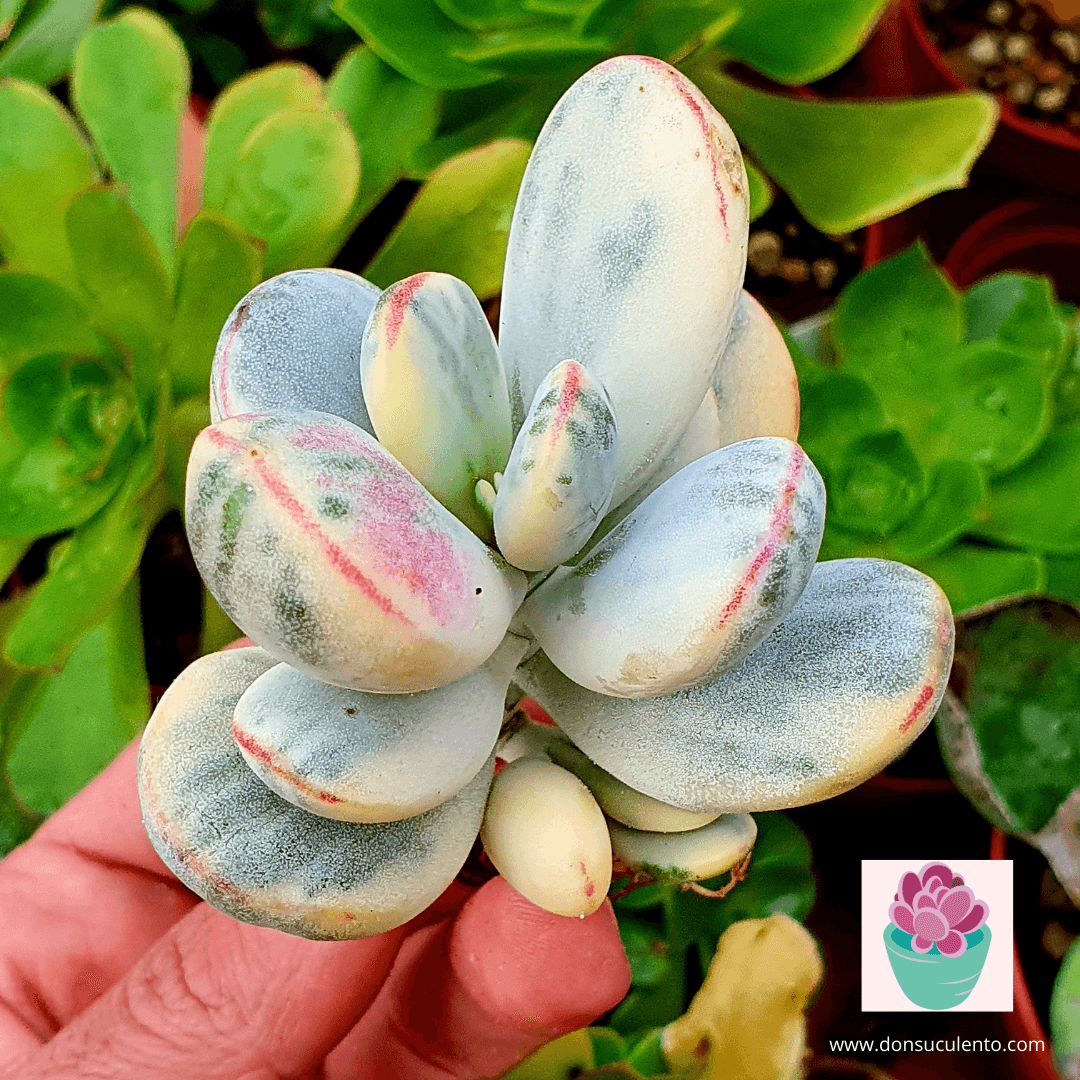
¿Cómo cuidar mi cotyledon orbiculata var oophilla variegado y que no muera en el intento?
Share
¿Cómo cuidar mi cotyledon orbiculata var oophilla variegado y que no muera en el intento?
Es una de las cinco plantas suculentas que considero más delicadas en cultivo. Es muy sencillo hacer que se sienta mal, sin embargo si consigues que se sienta bien, tendrá un crecimiento rápido y vigoroso, en definitiva, un regalo para la vista. Es una planta de difícil adaptación, pero una vez que lo hace, se desarrolla vigorosamente. Sufren mucho durante los viajes, sobre todo en verano. A continuación, te doy unos consejos para un buen mantenimiento:
Ubicación
Es una planta 100% exterior. Para mantenerla en el interior necesitarías; luces, aireación etc. No soporta bien los cambios de temperatura, no puede tener ni calefacción, ni aire acondicionado.
Como la mayoría de las cotyledones reposan en verano cuando las temperaturas son altas y está más activa en otoño/invierno/primavera. Aunque con un clima suave se puede mantener activid durante todo el año.
Al ser una planta variegada, sobre todo los ejemplares jóvenes, a partir de mayo hay que protegerla del sol y colocarla en una ubicación que está filtrado o directamente a la sombra, donde tenga mucha luminosidad hasta finales de Septiembre.
Le gusta la estabilidad, no andar cambiando de ubicación de manera continua.
Humedad y el riego
Cuando son jóvenes, es de las plantas más susceptibles a la humedad. Hay que evitar regar las hojas directamente, hasta que no sean ejemplares adultos y estables. No necesita ser regada en abundancia.
No se puede regar con temperaturas mínimas menores de 8º o por encima de 32º grados de máxima de forma continuada. La planta está con la actividad en reposo y no necesita agua, si la tuviera se convertiría en el caldo perfecto para que proliferen los hongos en ambas situaciones.
Substrato
Requiere un substrato cuanto más mineral mejor para evitar el encharcamiento y que absorba el exceso de humedad. Un 50% de substrato universal y otro 50% de grava volcánica, pomice o akamada de volumetría pequeña para que no retenga humedad, es la combinación perfecta. Evitaría la perlita y sobre todo vermiculita, ambas son retenedoras de humedad.

How to take care of your Cotyledon Orbiculata Var Oophylla Variegata, so it doesn’t die in the process.
This variegation is one of the five succulents that I consider to be the most delicate. To make this plant uncomfortable is very easy. However, if you make it feel comfortable, the succie will grow fast and vigorously; something beautiful to watch. This plant may not adapt itself well, but once it does, it will grow stronger. Also, bear in mind that this succulent suffers a lot when traveling, during the summer especially. Check the following tips for good maintenance:
Location
The Cotyledon is a 100% outdoor plant. You will need lights and ventilation to keep it inside. Your plant doesn’t stand temperature changes and can’t be in a heated environment or where the AC is on.
As the majority of the Cotyledon variegations, this succulent rests during the summer when the temperatures are high, and it’s more active in the fall/winter/spring. However, you might keep it more active throughout the year if your plant is in a mild climate.
From May out, protect your Cotyledon from the sun (especially younger plants). Using a shade cloth or placing it in the shade, where it’s bright, is the best place to keep your succulent. Don’t forget to do this at least till September.
This succie loves stability and doesn’t like to be changed locations often.
Humidity and watering
This variegation, when it is young, is one of the most vulnerable to humidity. You should avoid watering the leaves directly, not until the plant has reached its maturity and is stable. There is no need to water your plant in abundance.
You should also avoid water this succulent constantly under minimum temperatures of 8 degrees Celsius or above 32. This plant is continually active even without water. If you failed to do this, in both scenarios, fungi would grow.
Substrate
This succie needs a high-level mineral substrate. The reason for this is to avoid all the flooding and soaking of the humidity in excess. The perfect combination is using 50% of a universal substrate and another 50% of volcanic gravel, a small volumetry of pumice or Akamada, so humidity doesn’t remain. As a piece of advice, stay away from perlite and mostly vermiculite because they are great humidity keepers.


